Global Business: Circular Economy: Design and Models
VerifiedAdded on 2023/01/12
|11
|3722
|84
Report
AI Summary
This report delves into the concept of the circular economy as a solution to ecological crises, examining its core principles and benefits over the traditional linear model. It explores various case studies, including Biopak's biodegradable packaging, DSM Niaga's redesign of bulky products, innovative office furniture models, Google's data center practices, and REEP technology's approach to paper usage. The report further analyzes reverse cycles, such as Yerdle's online platform for scaling reuse and JLG's equipment reconditioning and financing, highlighting the importance of closed-loop systems, renewable resources, and extracting maximum value from products to minimize waste and promote sustainability in global business.
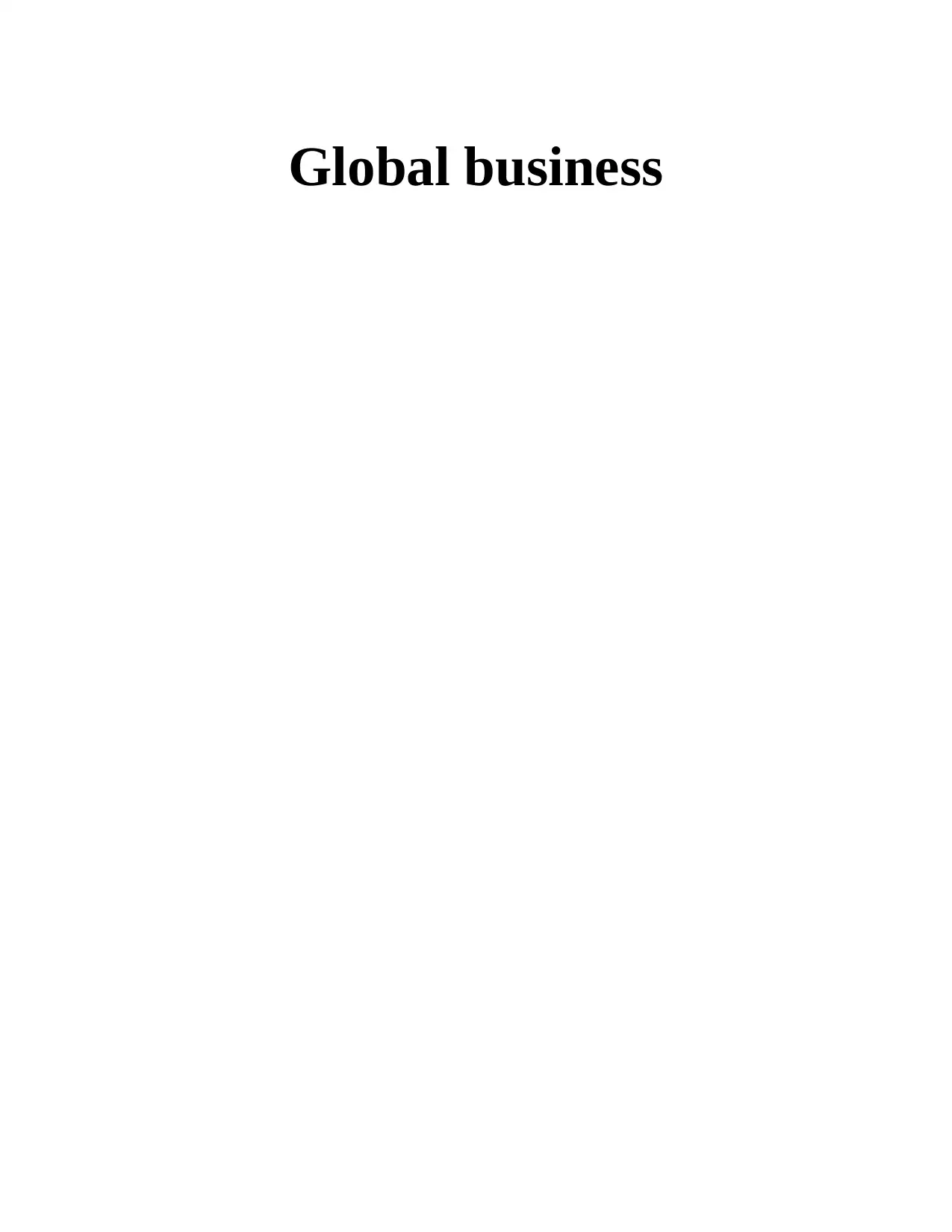
Global business
Paraphrase This Document
Need a fresh take? Get an instant paraphrase of this document with our AI Paraphraser
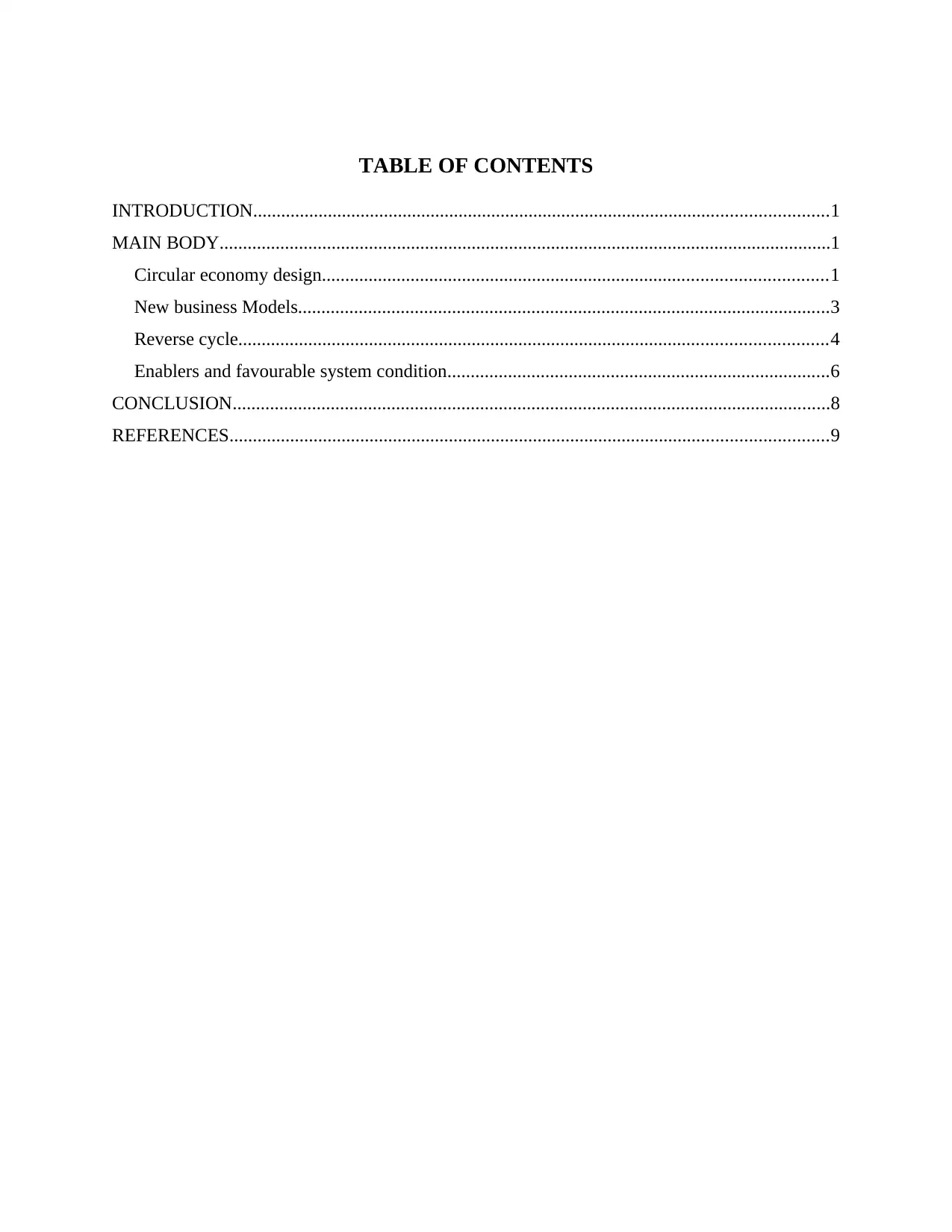
TABLE OF CONTENTS
INTRODUCTION...........................................................................................................................1
MAIN BODY...................................................................................................................................1
Circular economy design............................................................................................................1
New business Models..................................................................................................................3
Reverse cycle..............................................................................................................................4
Enablers and favourable system condition..................................................................................6
CONCLUSION................................................................................................................................8
REFERENCES................................................................................................................................9
INTRODUCTION...........................................................................................................................1
MAIN BODY...................................................................................................................................1
Circular economy design............................................................................................................1
New business Models..................................................................................................................3
Reverse cycle..............................................................................................................................4
Enablers and favourable system condition..................................................................................6
CONCLUSION................................................................................................................................8
REFERENCES................................................................................................................................9
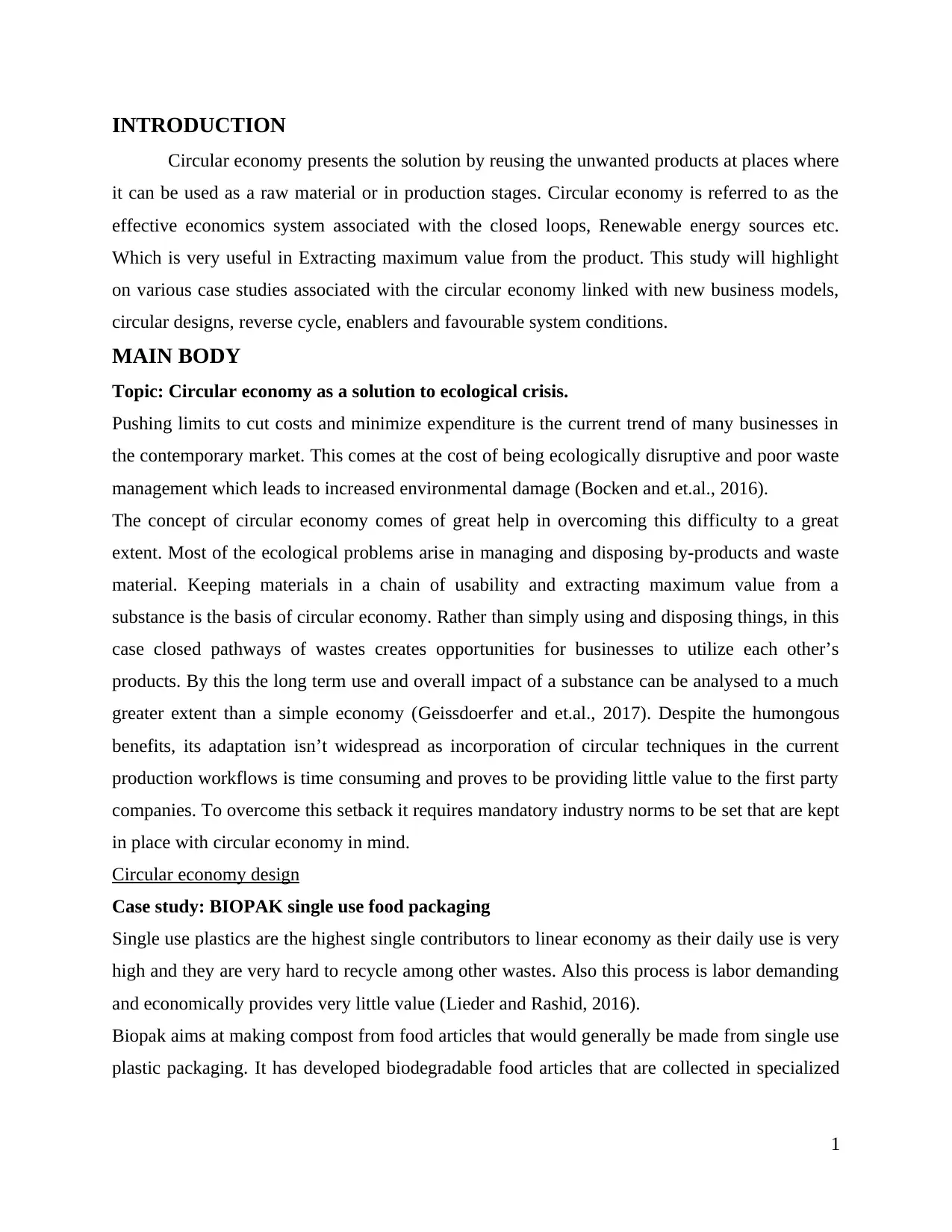
INTRODUCTION
Circular economy presents the solution by reusing the unwanted products at places where
it can be used as a raw material or in production stages. Circular economy is referred to as the
effective economics system associated with the closed loops, Renewable energy sources etc.
Which is very useful in Extracting maximum value from the product. This study will highlight
on various case studies associated with the circular economy linked with new business models,
circular designs, reverse cycle, enablers and favourable system conditions.
MAIN BODY
Topic: Circular economy as a solution to ecological crisis.
Pushing limits to cut costs and minimize expenditure is the current trend of many businesses in
the contemporary market. This comes at the cost of being ecologically disruptive and poor waste
management which leads to increased environmental damage (Bocken and et.al., 2016).
The concept of circular economy comes of great help in overcoming this difficulty to a great
extent. Most of the ecological problems arise in managing and disposing by-products and waste
material. Keeping materials in a chain of usability and extracting maximum value from a
substance is the basis of circular economy. Rather than simply using and disposing things, in this
case closed pathways of wastes creates opportunities for businesses to utilize each other’s
products. By this the long term use and overall impact of a substance can be analysed to a much
greater extent than a simple economy (Geissdoerfer and et.al., 2017). Despite the humongous
benefits, its adaptation isn’t widespread as incorporation of circular techniques in the current
production workflows is time consuming and proves to be providing little value to the first party
companies. To overcome this setback it requires mandatory industry norms to be set that are kept
in place with circular economy in mind.
Circular economy design
Case study: BIOPAK single use food packaging
Single use plastics are the highest single contributors to linear economy as their daily use is very
high and they are very hard to recycle among other wastes. Also this process is labor demanding
and economically provides very little value (Lieder and Rashid, 2016).
Biopak aims at making compost from food articles that would generally be made from single use
plastic packaging. It has developed biodegradable food articles that are collected in specialized
1
Circular economy presents the solution by reusing the unwanted products at places where
it can be used as a raw material or in production stages. Circular economy is referred to as the
effective economics system associated with the closed loops, Renewable energy sources etc.
Which is very useful in Extracting maximum value from the product. This study will highlight
on various case studies associated with the circular economy linked with new business models,
circular designs, reverse cycle, enablers and favourable system conditions.
MAIN BODY
Topic: Circular economy as a solution to ecological crisis.
Pushing limits to cut costs and minimize expenditure is the current trend of many businesses in
the contemporary market. This comes at the cost of being ecologically disruptive and poor waste
management which leads to increased environmental damage (Bocken and et.al., 2016).
The concept of circular economy comes of great help in overcoming this difficulty to a great
extent. Most of the ecological problems arise in managing and disposing by-products and waste
material. Keeping materials in a chain of usability and extracting maximum value from a
substance is the basis of circular economy. Rather than simply using and disposing things, in this
case closed pathways of wastes creates opportunities for businesses to utilize each other’s
products. By this the long term use and overall impact of a substance can be analysed to a much
greater extent than a simple economy (Geissdoerfer and et.al., 2017). Despite the humongous
benefits, its adaptation isn’t widespread as incorporation of circular techniques in the current
production workflows is time consuming and proves to be providing little value to the first party
companies. To overcome this setback it requires mandatory industry norms to be set that are kept
in place with circular economy in mind.
Circular economy design
Case study: BIOPAK single use food packaging
Single use plastics are the highest single contributors to linear economy as their daily use is very
high and they are very hard to recycle among other wastes. Also this process is labor demanding
and economically provides very little value (Lieder and Rashid, 2016).
Biopak aims at making compost from food articles that would generally be made from single use
plastic packaging. It has developed biodegradable food articles that are collected in specialized
1
⊘ This is a preview!⊘
Do you want full access?
Subscribe today to unlock all pages.

Trusted by 1+ million students worldwide

dustbins and then buried under soil for composting. This reduces the amount of plastic that
would otherwise end up in landfills.
Usually these recycling efforts would not be classified under circular economy itself. The reason
why Biopak qualifies as a circular economy is due to its collection and management service. The
packaging is made from plant based materials which easily decomposes rather than plastics
which have degrading periods of millions of years (Manninen and et.al., 2018). The service
requires people to throw their food articles in its collection green dustbins which are specialized
to collect only biodegradable food articles.
The workers then transfer these into land areas made for composting. The holes are specially
designed to have optimum decomposition. After a few days the compost is ready to be collected
in small quantities and packaged as fertilizers for farming.
This has proved to be particularly effective in developed countries like Australia and New
Zealand where the company has been operating since many years and the high costs of operating
can be accounted by the government.
A 2018 research showed that methane is produced in landfills which contributes to global
warming (Planing, 2015). Much of the waste in landfills is biodegradable but it cannot be done
properly due to contamination. This problem is greatly solved in this process.
Further, Biopak can also aim to bring more materials in this circular economy like other plastics
and packaging material. This will start chain networking of different products that can be
collectively be drawn under circular economy (Schulte, 2013).
Case study: Redesigning medium life heavy and bulky products from the scratch. A case
study on DSM Niaga.
One of the biggest challenge is that, medium life bulky products such as mattresses and
carpets are considered to be very difficult to recycle because it contains high amount of toxic
chemicals (Ellen Macarthur Foundation, 2020). Every year approximately 1. Million kgs of
carpets ends in incineration. DSM Niaga has developed 3 design principles which are
considered to be underpinned by the thinking of circular economy. This approach has resulted in
your production of technologies for development of new medium life products. The company
focuses on designing an adhesive approach. The modular design helps in supporting easy
maintenance of the meeting let the dogs which helps in easily recycling mono material
components (Korhonen, Honkasalo and Seppälä, 2018). The key benefit of this project is that
2
would otherwise end up in landfills.
Usually these recycling efforts would not be classified under circular economy itself. The reason
why Biopak qualifies as a circular economy is due to its collection and management service. The
packaging is made from plant based materials which easily decomposes rather than plastics
which have degrading periods of millions of years (Manninen and et.al., 2018). The service
requires people to throw their food articles in its collection green dustbins which are specialized
to collect only biodegradable food articles.
The workers then transfer these into land areas made for composting. The holes are specially
designed to have optimum decomposition. After a few days the compost is ready to be collected
in small quantities and packaged as fertilizers for farming.
This has proved to be particularly effective in developed countries like Australia and New
Zealand where the company has been operating since many years and the high costs of operating
can be accounted by the government.
A 2018 research showed that methane is produced in landfills which contributes to global
warming (Planing, 2015). Much of the waste in landfills is biodegradable but it cannot be done
properly due to contamination. This problem is greatly solved in this process.
Further, Biopak can also aim to bring more materials in this circular economy like other plastics
and packaging material. This will start chain networking of different products that can be
collectively be drawn under circular economy (Schulte, 2013).
Case study: Redesigning medium life heavy and bulky products from the scratch. A case
study on DSM Niaga.
One of the biggest challenge is that, medium life bulky products such as mattresses and
carpets are considered to be very difficult to recycle because it contains high amount of toxic
chemicals (Ellen Macarthur Foundation, 2020). Every year approximately 1. Million kgs of
carpets ends in incineration. DSM Niaga has developed 3 design principles which are
considered to be underpinned by the thinking of circular economy. This approach has resulted in
your production of technologies for development of new medium life products. The company
focuses on designing an adhesive approach. The modular design helps in supporting easy
maintenance of the meeting let the dogs which helps in easily recycling mono material
components (Korhonen, Honkasalo and Seppälä, 2018). The key benefit of this project is that
2
Paraphrase This Document
Need a fresh take? Get an instant paraphrase of this document with our AI Paraphraser
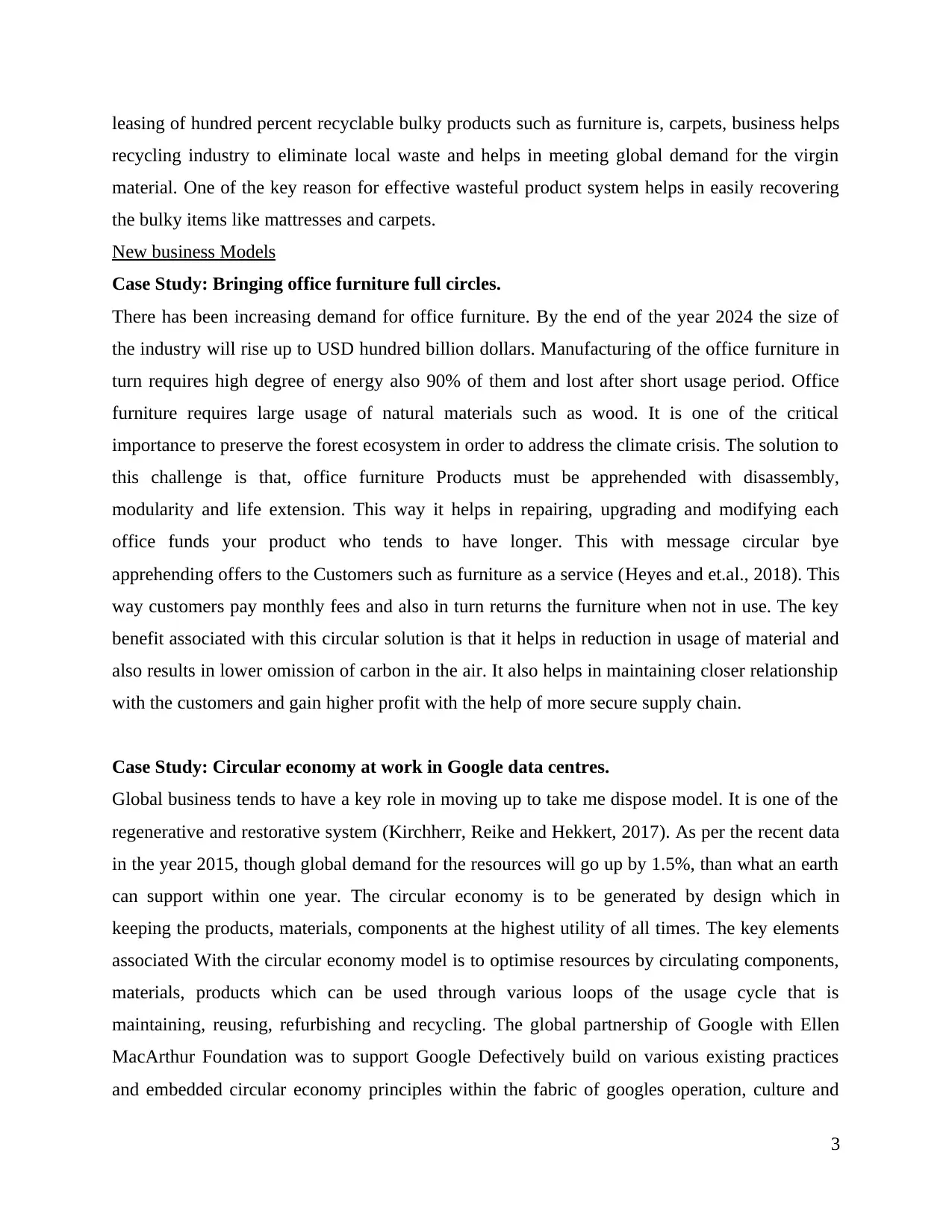
leasing of hundred percent recyclable bulky products such as furniture is, carpets, business helps
recycling industry to eliminate local waste and helps in meeting global demand for the virgin
material. One of the key reason for effective wasteful product system helps in easily recovering
the bulky items like mattresses and carpets.
New business Models
Case Study: Bringing office furniture full circles.
There has been increasing demand for office furniture. By the end of the year 2024 the size of
the industry will rise up to USD hundred billion dollars. Manufacturing of the office furniture in
turn requires high degree of energy also 90% of them and lost after short usage period. Office
furniture requires large usage of natural materials such as wood. It is one of the critical
importance to preserve the forest ecosystem in order to address the climate crisis. The solution to
this challenge is that, office furniture Products must be apprehended with disassembly,
modularity and life extension. This way it helps in repairing, upgrading and modifying each
office funds your product who tends to have longer. This with message circular bye
apprehending offers to the Customers such as furniture as a service (Heyes and et.al., 2018). This
way customers pay monthly fees and also in turn returns the furniture when not in use. The key
benefit associated with this circular solution is that it helps in reduction in usage of material and
also results in lower omission of carbon in the air. It also helps in maintaining closer relationship
with the customers and gain higher profit with the help of more secure supply chain.
Case Study: Circular economy at work in Google data centres.
Global business tends to have a key role in moving up to take me dispose model. It is one of the
regenerative and restorative system (Kirchherr, Reike and Hekkert, 2017). As per the recent data
in the year 2015, though global demand for the resources will go up by 1.5%, than what an earth
can support within one year. The circular economy is to be generated by design which in
keeping the products, materials, components at the highest utility of all times. The key elements
associated With the circular economy model is to optimise resources by circulating components,
materials, products which can be used through various loops of the usage cycle that is
maintaining, reusing, refurbishing and recycling. The global partnership of Google with Ellen
MacArthur Foundation was to support Google Defectively build on various existing practices
and embedded circular economy principles within the fabric of googles operation, culture and
3
recycling industry to eliminate local waste and helps in meeting global demand for the virgin
material. One of the key reason for effective wasteful product system helps in easily recovering
the bulky items like mattresses and carpets.
New business Models
Case Study: Bringing office furniture full circles.
There has been increasing demand for office furniture. By the end of the year 2024 the size of
the industry will rise up to USD hundred billion dollars. Manufacturing of the office furniture in
turn requires high degree of energy also 90% of them and lost after short usage period. Office
furniture requires large usage of natural materials such as wood. It is one of the critical
importance to preserve the forest ecosystem in order to address the climate crisis. The solution to
this challenge is that, office furniture Products must be apprehended with disassembly,
modularity and life extension. This way it helps in repairing, upgrading and modifying each
office funds your product who tends to have longer. This with message circular bye
apprehending offers to the Customers such as furniture as a service (Heyes and et.al., 2018). This
way customers pay monthly fees and also in turn returns the furniture when not in use. The key
benefit associated with this circular solution is that it helps in reduction in usage of material and
also results in lower omission of carbon in the air. It also helps in maintaining closer relationship
with the customers and gain higher profit with the help of more secure supply chain.
Case Study: Circular economy at work in Google data centres.
Global business tends to have a key role in moving up to take me dispose model. It is one of the
regenerative and restorative system (Kirchherr, Reike and Hekkert, 2017). As per the recent data
in the year 2015, though global demand for the resources will go up by 1.5%, than what an earth
can support within one year. The circular economy is to be generated by design which in
keeping the products, materials, components at the highest utility of all times. The key elements
associated With the circular economy model is to optimise resources by circulating components,
materials, products which can be used through various loops of the usage cycle that is
maintaining, reusing, refurbishing and recycling. The global partnership of Google with Ellen
MacArthur Foundation was to support Google Defectively build on various existing practices
and embedded circular economy principles within the fabric of googles operation, culture and
3

infrastructure (Korhonen, Honkasalo and Seppälä, 2018). This practice has combined with the
circle approach of the Google in optimising the end of life which is based on total cost of
ownership principles which has resulted in cost avoidance of hundreds of billions of dollars.
Case Study: A circular economic approach towards using paper in the digital era.
One of the most prominent reason that circular economy framework is considered to be the most
powerful lens for innovation is because it offers redesigning potential. In order to be restore
sufficient one does not need to reduce the printing of the office rather one should print in circular
manner (Lacy and Rutqvist, 2016). There seems to be enormous growth in the usage of Mobile
devices, computers and editors which has resulted in less usage of the paper. The paper industry
tends to require substantial energy and water and landfill. REEP technology ltd. Has taken an
effective approach which helps in better usage of the paper. REEP process was launched in the
year 2012, which mainly compose of 2 elements. The first element is related with the ablation
resistant which is an erasable paper. On the contrary, other element is associated with a specific
device which contains laser that helps in erasing the page and also removes the toner from the
reengineered paper. This eventually helps in saving the content on the page and make the page
ready to be used again (Lewandowski, 2016). This helps in avoiding the purchase of reams of
paper is also paying for distribution, scanning, shredding, collecting and storage with the help of
REEP services. This is considered to be a cost saving approach without any up front investment.
Reverse cycle
1. Case study: The online platform for scaling reuse.
Today the main focus is to sell first. They miss out on big opportunities to capture additional
value in the secondary market and deepen their engagement with customers at the same time. this
Situation exists because the IT experts and resources required to set up the logistics and build out
the right web experience. And the value of items is lost unless the recycled usage is sold by the
3rd party.
Yerdle gives companies access to their own products in the secondary market by offering a
platform that makes it easy for brands to buy back and resell used items (Stahel, 2016).
It provides the brands with the logistics and technologies to develop customizable resale
channels that allow companies to gain access to the secondary market.
By offering used products, brands can also attract new customers who wouldn’t otherwise be
able or willing to pay full price.
4
circle approach of the Google in optimising the end of life which is based on total cost of
ownership principles which has resulted in cost avoidance of hundreds of billions of dollars.
Case Study: A circular economic approach towards using paper in the digital era.
One of the most prominent reason that circular economy framework is considered to be the most
powerful lens for innovation is because it offers redesigning potential. In order to be restore
sufficient one does not need to reduce the printing of the office rather one should print in circular
manner (Lacy and Rutqvist, 2016). There seems to be enormous growth in the usage of Mobile
devices, computers and editors which has resulted in less usage of the paper. The paper industry
tends to require substantial energy and water and landfill. REEP technology ltd. Has taken an
effective approach which helps in better usage of the paper. REEP process was launched in the
year 2012, which mainly compose of 2 elements. The first element is related with the ablation
resistant which is an erasable paper. On the contrary, other element is associated with a specific
device which contains laser that helps in erasing the page and also removes the toner from the
reengineered paper. This eventually helps in saving the content on the page and make the page
ready to be used again (Lewandowski, 2016). This helps in avoiding the purchase of reams of
paper is also paying for distribution, scanning, shredding, collecting and storage with the help of
REEP services. This is considered to be a cost saving approach without any up front investment.
Reverse cycle
1. Case study: The online platform for scaling reuse.
Today the main focus is to sell first. They miss out on big opportunities to capture additional
value in the secondary market and deepen their engagement with customers at the same time. this
Situation exists because the IT experts and resources required to set up the logistics and build out
the right web experience. And the value of items is lost unless the recycled usage is sold by the
3rd party.
Yerdle gives companies access to their own products in the secondary market by offering a
platform that makes it easy for brands to buy back and resell used items (Stahel, 2016).
It provides the brands with the logistics and technologies to develop customizable resale
channels that allow companies to gain access to the secondary market.
By offering used products, brands can also attract new customers who wouldn’t otherwise be
able or willing to pay full price.
4
⊘ This is a preview!⊘
Do you want full access?
Subscribe today to unlock all pages.

Trusted by 1+ million students worldwide
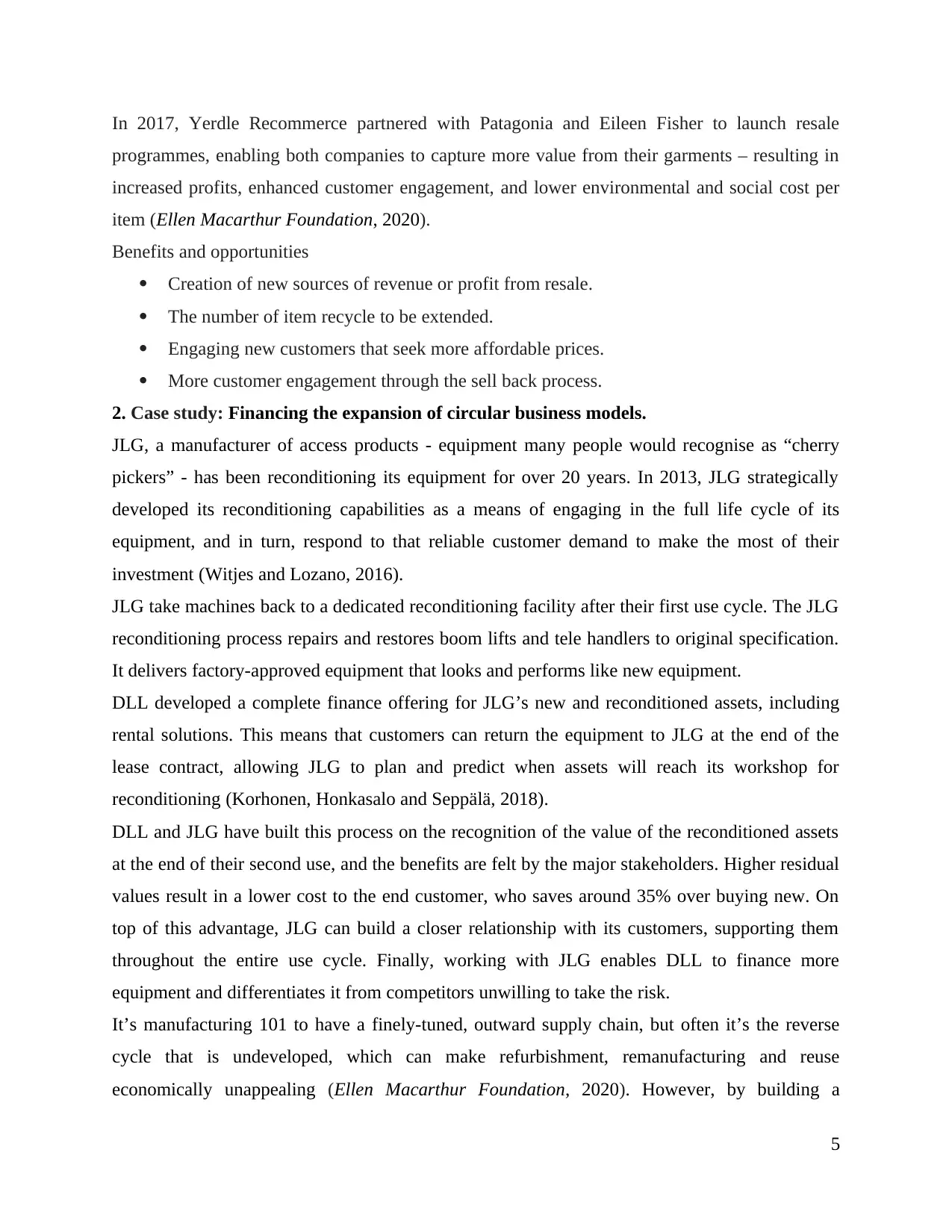
In 2017, Yerdle Recommerce partnered with Patagonia and Eileen Fisher to launch resale
programmes, enabling both companies to capture more value from their garments – resulting in
increased profits, enhanced customer engagement, and lower environmental and social cost per
item (Ellen Macarthur Foundation, 2020).
Benefits and opportunities
Creation of new sources of revenue or profit from resale.
The number of item recycle to be extended.
Engaging new customers that seek more affordable prices.
More customer engagement through the sell back process.
2. Case study: Financing the expansion of circular business models.
JLG, a manufacturer of access products - equipment many people would recognise as “cherry
pickers” - has been reconditioning its equipment for over 20 years. In 2013, JLG strategically
developed its reconditioning capabilities as a means of engaging in the full life cycle of its
equipment, and in turn, respond to that reliable customer demand to make the most of their
investment (Witjes and Lozano, 2016).
JLG take machines back to a dedicated reconditioning facility after their first use cycle. The JLG
reconditioning process repairs and restores boom lifts and tele handlers to original specification.
It delivers factory-approved equipment that looks and performs like new equipment.
DLL developed a complete finance offering for JLG’s new and reconditioned assets, including
rental solutions. This means that customers can return the equipment to JLG at the end of the
lease contract, allowing JLG to plan and predict when assets will reach its workshop for
reconditioning (Korhonen, Honkasalo and Seppälä, 2018).
DLL and JLG have built this process on the recognition of the value of the reconditioned assets
at the end of their second use, and the benefits are felt by the major stakeholders. Higher residual
values result in a lower cost to the end customer, who saves around 35% over buying new. On
top of this advantage, JLG can build a closer relationship with its customers, supporting them
throughout the entire use cycle. Finally, working with JLG enables DLL to finance more
equipment and differentiates it from competitors unwilling to take the risk.
It’s manufacturing 101 to have a finely-tuned, outward supply chain, but often it’s the reverse
cycle that is undeveloped, which can make refurbishment, remanufacturing and reuse
economically unappealing (Ellen Macarthur Foundation, 2020). However, by building a
5
programmes, enabling both companies to capture more value from their garments – resulting in
increased profits, enhanced customer engagement, and lower environmental and social cost per
item (Ellen Macarthur Foundation, 2020).
Benefits and opportunities
Creation of new sources of revenue or profit from resale.
The number of item recycle to be extended.
Engaging new customers that seek more affordable prices.
More customer engagement through the sell back process.
2. Case study: Financing the expansion of circular business models.
JLG, a manufacturer of access products - equipment many people would recognise as “cherry
pickers” - has been reconditioning its equipment for over 20 years. In 2013, JLG strategically
developed its reconditioning capabilities as a means of engaging in the full life cycle of its
equipment, and in turn, respond to that reliable customer demand to make the most of their
investment (Witjes and Lozano, 2016).
JLG take machines back to a dedicated reconditioning facility after their first use cycle. The JLG
reconditioning process repairs and restores boom lifts and tele handlers to original specification.
It delivers factory-approved equipment that looks and performs like new equipment.
DLL developed a complete finance offering for JLG’s new and reconditioned assets, including
rental solutions. This means that customers can return the equipment to JLG at the end of the
lease contract, allowing JLG to plan and predict when assets will reach its workshop for
reconditioning (Korhonen, Honkasalo and Seppälä, 2018).
DLL and JLG have built this process on the recognition of the value of the reconditioned assets
at the end of their second use, and the benefits are felt by the major stakeholders. Higher residual
values result in a lower cost to the end customer, who saves around 35% over buying new. On
top of this advantage, JLG can build a closer relationship with its customers, supporting them
throughout the entire use cycle. Finally, working with JLG enables DLL to finance more
equipment and differentiates it from competitors unwilling to take the risk.
It’s manufacturing 101 to have a finely-tuned, outward supply chain, but often it’s the reverse
cycle that is undeveloped, which can make refurbishment, remanufacturing and reuse
economically unappealing (Ellen Macarthur Foundation, 2020). However, by building a
5
Paraphrase This Document
Need a fresh take? Get an instant paraphrase of this document with our AI Paraphraser
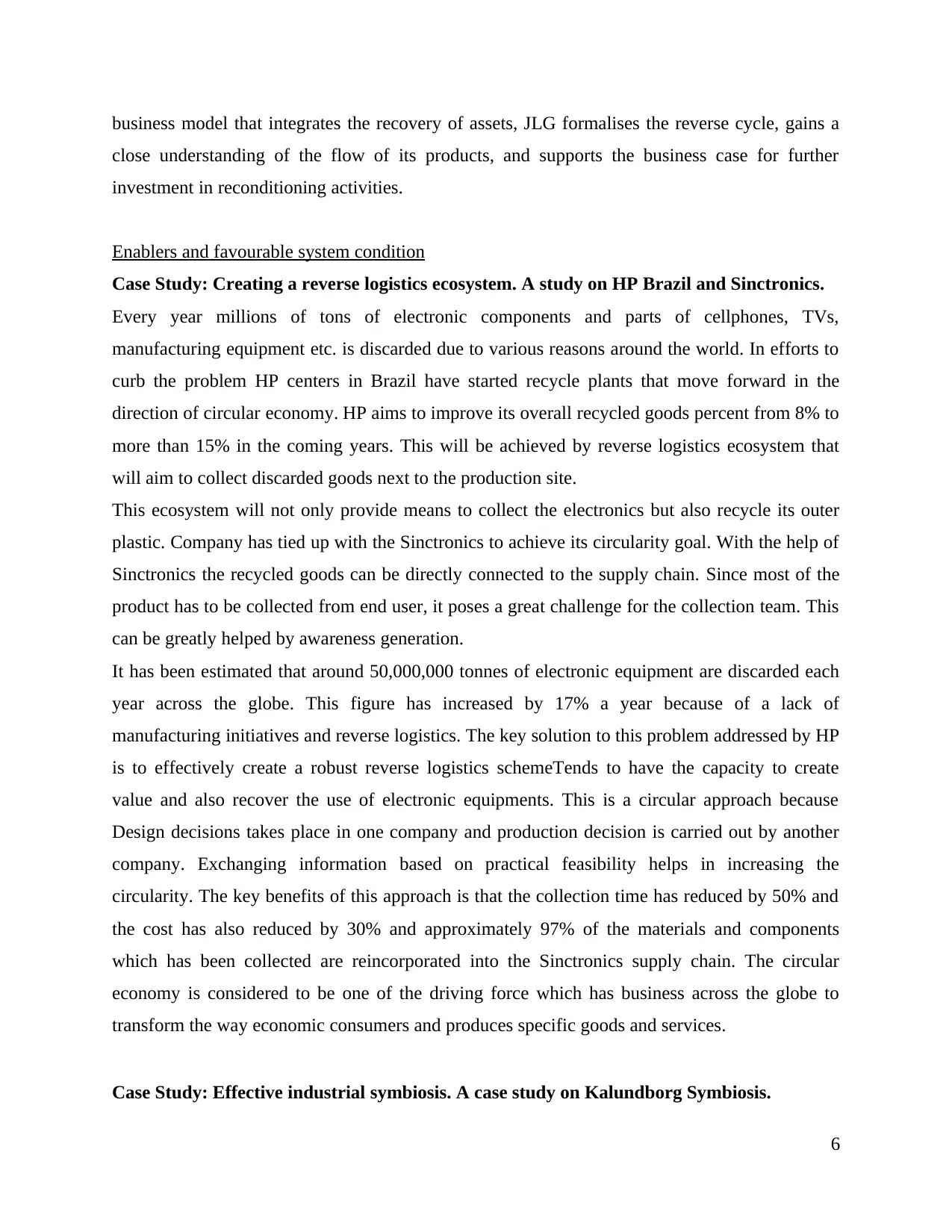
business model that integrates the recovery of assets, JLG formalises the reverse cycle, gains a
close understanding of the flow of its products, and supports the business case for further
investment in reconditioning activities.
Enablers and favourable system condition
Case Study: Creating a reverse logistics ecosystem. A study on HP Brazil and Sinctronics.
Every year millions of tons of electronic components and parts of cellphones, TVs,
manufacturing equipment etc. is discarded due to various reasons around the world. In efforts to
curb the problem HP centers in Brazil have started recycle plants that move forward in the
direction of circular economy. HP aims to improve its overall recycled goods percent from 8% to
more than 15% in the coming years. This will be achieved by reverse logistics ecosystem that
will aim to collect discarded goods next to the production site.
This ecosystem will not only provide means to collect the electronics but also recycle its outer
plastic. Company has tied up with the Sinctronics to achieve its circularity goal. With the help of
Sinctronics the recycled goods can be directly connected to the supply chain. Since most of the
product has to be collected from end user, it poses a great challenge for the collection team. This
can be greatly helped by awareness generation.
It has been estimated that around 50,000,000 tonnes of electronic equipment are discarded each
year across the globe. This figure has increased by 17% a year because of a lack of
manufacturing initiatives and reverse logistics. The key solution to this problem addressed by HP
is to effectively create a robust reverse logistics schemeTends to have the capacity to create
value and also recover the use of electronic equipments. This is a circular approach because
Design decisions takes place in one company and production decision is carried out by another
company. Exchanging information based on practical feasibility helps in increasing the
circularity. The key benefits of this approach is that the collection time has reduced by 50% and
the cost has also reduced by 30% and approximately 97% of the materials and components
which has been collected are reincorporated into the Sinctronics supply chain. The circular
economy is considered to be one of the driving force which has business across the globe to
transform the way economic consumers and produces specific goods and services.
Case Study: Effective industrial symbiosis. A case study on Kalundborg Symbiosis.
6
close understanding of the flow of its products, and supports the business case for further
investment in reconditioning activities.
Enablers and favourable system condition
Case Study: Creating a reverse logistics ecosystem. A study on HP Brazil and Sinctronics.
Every year millions of tons of electronic components and parts of cellphones, TVs,
manufacturing equipment etc. is discarded due to various reasons around the world. In efforts to
curb the problem HP centers in Brazil have started recycle plants that move forward in the
direction of circular economy. HP aims to improve its overall recycled goods percent from 8% to
more than 15% in the coming years. This will be achieved by reverse logistics ecosystem that
will aim to collect discarded goods next to the production site.
This ecosystem will not only provide means to collect the electronics but also recycle its outer
plastic. Company has tied up with the Sinctronics to achieve its circularity goal. With the help of
Sinctronics the recycled goods can be directly connected to the supply chain. Since most of the
product has to be collected from end user, it poses a great challenge for the collection team. This
can be greatly helped by awareness generation.
It has been estimated that around 50,000,000 tonnes of electronic equipment are discarded each
year across the globe. This figure has increased by 17% a year because of a lack of
manufacturing initiatives and reverse logistics. The key solution to this problem addressed by HP
is to effectively create a robust reverse logistics schemeTends to have the capacity to create
value and also recover the use of electronic equipments. This is a circular approach because
Design decisions takes place in one company and production decision is carried out by another
company. Exchanging information based on practical feasibility helps in increasing the
circularity. The key benefits of this approach is that the collection time has reduced by 50% and
the cost has also reduced by 30% and approximately 97% of the materials and components
which has been collected are reincorporated into the Sinctronics supply chain. The circular
economy is considered to be one of the driving force which has business across the globe to
transform the way economic consumers and produces specific goods and services.
Case Study: Effective industrial symbiosis. A case study on Kalundborg Symbiosis.
6
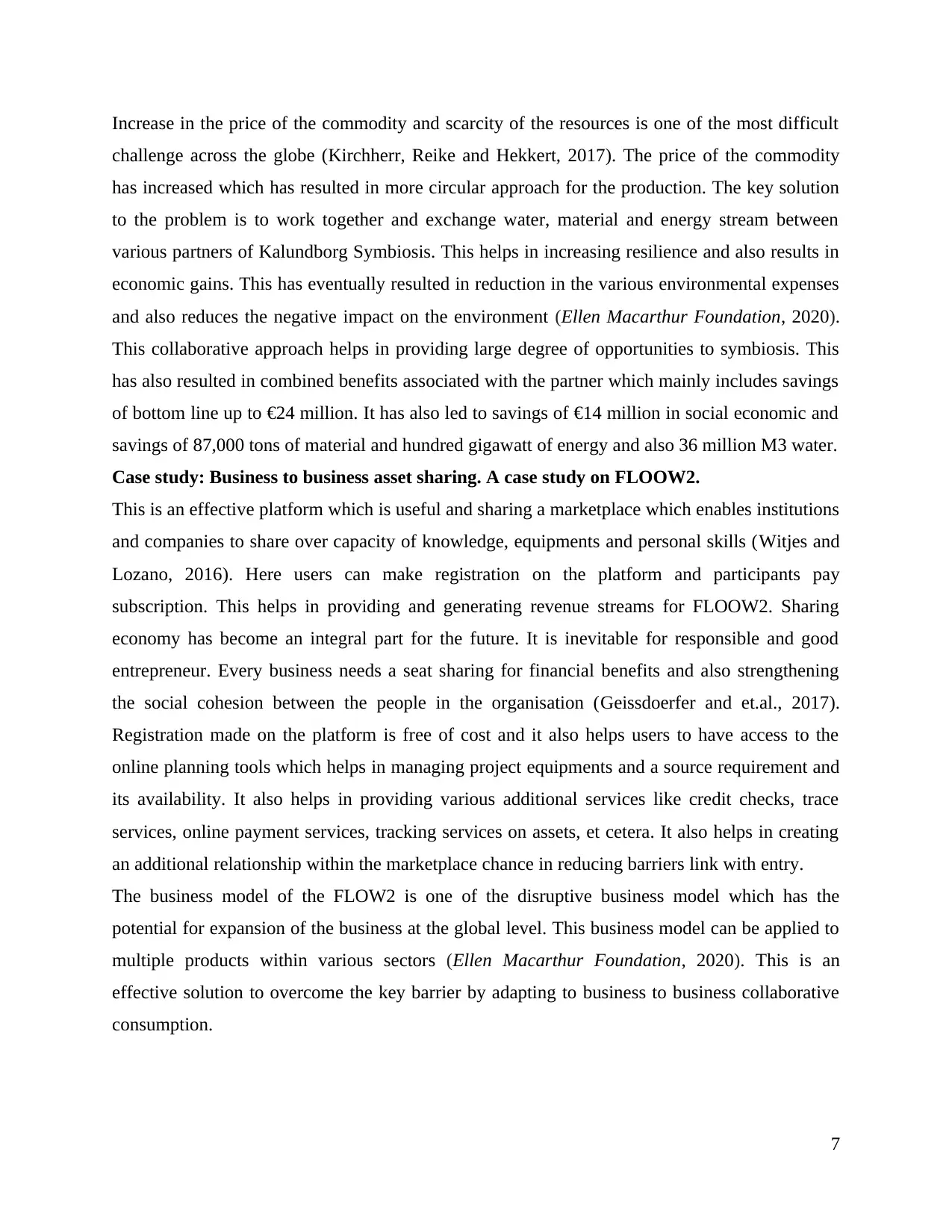
Increase in the price of the commodity and scarcity of the resources is one of the most difficult
challenge across the globe (Kirchherr, Reike and Hekkert, 2017). The price of the commodity
has increased which has resulted in more circular approach for the production. The key solution
to the problem is to work together and exchange water, material and energy stream between
various partners of Kalundborg Symbiosis. This helps in increasing resilience and also results in
economic gains. This has eventually resulted in reduction in the various environmental expenses
and also reduces the negative impact on the environment (Ellen Macarthur Foundation, 2020).
This collaborative approach helps in providing large degree of opportunities to symbiosis. This
has also resulted in combined benefits associated with the partner which mainly includes savings
of bottom line up to €24 million. It has also led to savings of €14 million in social economic and
savings of 87,000 tons of material and hundred gigawatt of energy and also 36 million M3 water.
Case study: Business to business asset sharing. A case study on FLOOW2.
This is an effective platform which is useful and sharing a marketplace which enables institutions
and companies to share over capacity of knowledge, equipments and personal skills (Witjes and
Lozano, 2016). Here users can make registration on the platform and participants pay
subscription. This helps in providing and generating revenue streams for FLOOW2. Sharing
economy has become an integral part for the future. It is inevitable for responsible and good
entrepreneur. Every business needs a seat sharing for financial benefits and also strengthening
the social cohesion between the people in the organisation (Geissdoerfer and et.al., 2017).
Registration made on the platform is free of cost and it also helps users to have access to the
online planning tools which helps in managing project equipments and a source requirement and
its availability. It also helps in providing various additional services like credit checks, trace
services, online payment services, tracking services on assets, et cetera. It also helps in creating
an additional relationship within the marketplace chance in reducing barriers link with entry.
The business model of the FLOW2 is one of the disruptive business model which has the
potential for expansion of the business at the global level. This business model can be applied to
multiple products within various sectors (Ellen Macarthur Foundation, 2020). This is an
effective solution to overcome the key barrier by adapting to business to business collaborative
consumption.
7
challenge across the globe (Kirchherr, Reike and Hekkert, 2017). The price of the commodity
has increased which has resulted in more circular approach for the production. The key solution
to the problem is to work together and exchange water, material and energy stream between
various partners of Kalundborg Symbiosis. This helps in increasing resilience and also results in
economic gains. This has eventually resulted in reduction in the various environmental expenses
and also reduces the negative impact on the environment (Ellen Macarthur Foundation, 2020).
This collaborative approach helps in providing large degree of opportunities to symbiosis. This
has also resulted in combined benefits associated with the partner which mainly includes savings
of bottom line up to €24 million. It has also led to savings of €14 million in social economic and
savings of 87,000 tons of material and hundred gigawatt of energy and also 36 million M3 water.
Case study: Business to business asset sharing. A case study on FLOOW2.
This is an effective platform which is useful and sharing a marketplace which enables institutions
and companies to share over capacity of knowledge, equipments and personal skills (Witjes and
Lozano, 2016). Here users can make registration on the platform and participants pay
subscription. This helps in providing and generating revenue streams for FLOOW2. Sharing
economy has become an integral part for the future. It is inevitable for responsible and good
entrepreneur. Every business needs a seat sharing for financial benefits and also strengthening
the social cohesion between the people in the organisation (Geissdoerfer and et.al., 2017).
Registration made on the platform is free of cost and it also helps users to have access to the
online planning tools which helps in managing project equipments and a source requirement and
its availability. It also helps in providing various additional services like credit checks, trace
services, online payment services, tracking services on assets, et cetera. It also helps in creating
an additional relationship within the marketplace chance in reducing barriers link with entry.
The business model of the FLOW2 is one of the disruptive business model which has the
potential for expansion of the business at the global level. This business model can be applied to
multiple products within various sectors (Ellen Macarthur Foundation, 2020). This is an
effective solution to overcome the key barrier by adapting to business to business collaborative
consumption.
7
⊘ This is a preview!⊘
Do you want full access?
Subscribe today to unlock all pages.

Trusted by 1+ million students worldwide
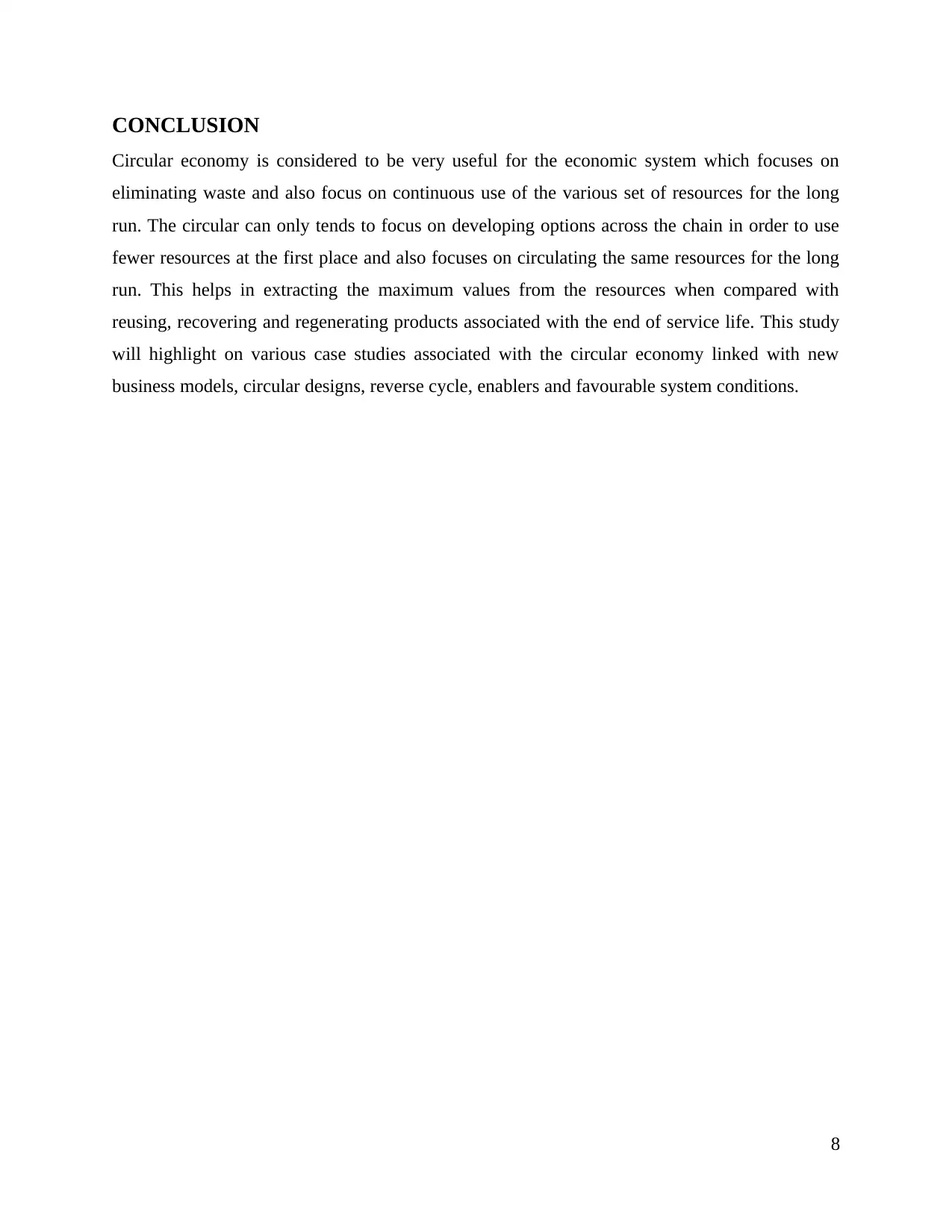
CONCLUSION
Circular economy is considered to be very useful for the economic system which focuses on
eliminating waste and also focus on continuous use of the various set of resources for the long
run. The circular can only tends to focus on developing options across the chain in order to use
fewer resources at the first place and also focuses on circulating the same resources for the long
run. This helps in extracting the maximum values from the resources when compared with
reusing, recovering and regenerating products associated with the end of service life. This study
will highlight on various case studies associated with the circular economy linked with new
business models, circular designs, reverse cycle, enablers and favourable system conditions.
8
Circular economy is considered to be very useful for the economic system which focuses on
eliminating waste and also focus on continuous use of the various set of resources for the long
run. The circular can only tends to focus on developing options across the chain in order to use
fewer resources at the first place and also focuses on circulating the same resources for the long
run. This helps in extracting the maximum values from the resources when compared with
reusing, recovering and regenerating products associated with the end of service life. This study
will highlight on various case studies associated with the circular economy linked with new
business models, circular designs, reverse cycle, enablers and favourable system conditions.
8
Paraphrase This Document
Need a fresh take? Get an instant paraphrase of this document with our AI Paraphraser

REFERENCES
Books and Journals
Bocken, N.M and et.al., 2016. Product design and business model strategies for a circular
economy. Journal of Industrial and Production Engineering, 33(5), pp.308-320.
Geissdoerfer, M and et.al., 2017. The Circular Economy–A new sustainability
paradigm?. Journal of cleaner production, 143, pp.757-768.
Heyes, G and et.al., 2018. Developing and implementing circular economy business models in
service-oriented technology companies. Journal of Cleaner Production, 177, pp.621-632.
Kirchherr, J., Reike, D. and Hekkert, M., 2017. Conceptualizing the circular economy: An
analysis of 114 definitions. Resources, conservation and recycling, 127, pp.221-232.
Korhonen, J., Honkasalo, A. and Seppälä, J., 2018. Circular economy: the concept and its
limitations. Ecological economics, 143, pp.37-46.
Lacy, P. and Rutqvist, J., 2016. Waste to wealth: The circular economy advantage. Springer.
Lewandowski, M., 2016. Designing the business models for circular economy—Towards the
conceptual framework. Sustainability, 8(1), p.43.
Lieder, M. and Rashid, A., 2016. Towards circular economy implementation: a comprehensive
review in context of manufacturing industry. Journal of cleaner production, 115, pp.36-51.
Manninen, K and et.al., 2018. Do circular economy business models capture intended
environmental value propositions?. Journal of Cleaner Production, 171, pp.413-422.
Planing, P., 2015. Business model innovation in a circular economy reasons for non-acceptance
of circular business models. Open journal of business model innovation, 1(11).
Schulte, U.G., 2013. New business models for a radical change in resource
efficiency. Environmental Innovation and Societal Transitions, 9, pp.43-47.
Stahel, W.R., 2016. The circular economy. Nature, 531(7595), pp.435-438.
Witjes, S. and Lozano, R., 2016. Towards a more Circular Economy: Proposing a framework
linking sustainable public procurement and sustainable business models. Resources,
Conservation and Recycling, 112, pp.37-44.
Online
Ellen Macarthur Foundation. 2020. [ONLINE]. Available through<
https://www.ellenmacarthurfoundation.org/case-studies/business/building-blocks/new-business-
models>
9
Books and Journals
Bocken, N.M and et.al., 2016. Product design and business model strategies for a circular
economy. Journal of Industrial and Production Engineering, 33(5), pp.308-320.
Geissdoerfer, M and et.al., 2017. The Circular Economy–A new sustainability
paradigm?. Journal of cleaner production, 143, pp.757-768.
Heyes, G and et.al., 2018. Developing and implementing circular economy business models in
service-oriented technology companies. Journal of Cleaner Production, 177, pp.621-632.
Kirchherr, J., Reike, D. and Hekkert, M., 2017. Conceptualizing the circular economy: An
analysis of 114 definitions. Resources, conservation and recycling, 127, pp.221-232.
Korhonen, J., Honkasalo, A. and Seppälä, J., 2018. Circular economy: the concept and its
limitations. Ecological economics, 143, pp.37-46.
Lacy, P. and Rutqvist, J., 2016. Waste to wealth: The circular economy advantage. Springer.
Lewandowski, M., 2016. Designing the business models for circular economy—Towards the
conceptual framework. Sustainability, 8(1), p.43.
Lieder, M. and Rashid, A., 2016. Towards circular economy implementation: a comprehensive
review in context of manufacturing industry. Journal of cleaner production, 115, pp.36-51.
Manninen, K and et.al., 2018. Do circular economy business models capture intended
environmental value propositions?. Journal of Cleaner Production, 171, pp.413-422.
Planing, P., 2015. Business model innovation in a circular economy reasons for non-acceptance
of circular business models. Open journal of business model innovation, 1(11).
Schulte, U.G., 2013. New business models for a radical change in resource
efficiency. Environmental Innovation and Societal Transitions, 9, pp.43-47.
Stahel, W.R., 2016. The circular economy. Nature, 531(7595), pp.435-438.
Witjes, S. and Lozano, R., 2016. Towards a more Circular Economy: Proposing a framework
linking sustainable public procurement and sustainable business models. Resources,
Conservation and Recycling, 112, pp.37-44.
Online
Ellen Macarthur Foundation. 2020. [ONLINE]. Available through<
https://www.ellenmacarthurfoundation.org/case-studies/business/building-blocks/new-business-
models>
9
1 out of 11
Related Documents
Your All-in-One AI-Powered Toolkit for Academic Success.
+13062052269
info@desklib.com
Available 24*7 on WhatsApp / Email
![[object Object]](/_next/static/media/star-bottom.7253800d.svg)
Unlock your academic potential
Copyright © 2020–2025 A2Z Services. All Rights Reserved. Developed and managed by ZUCOL.





